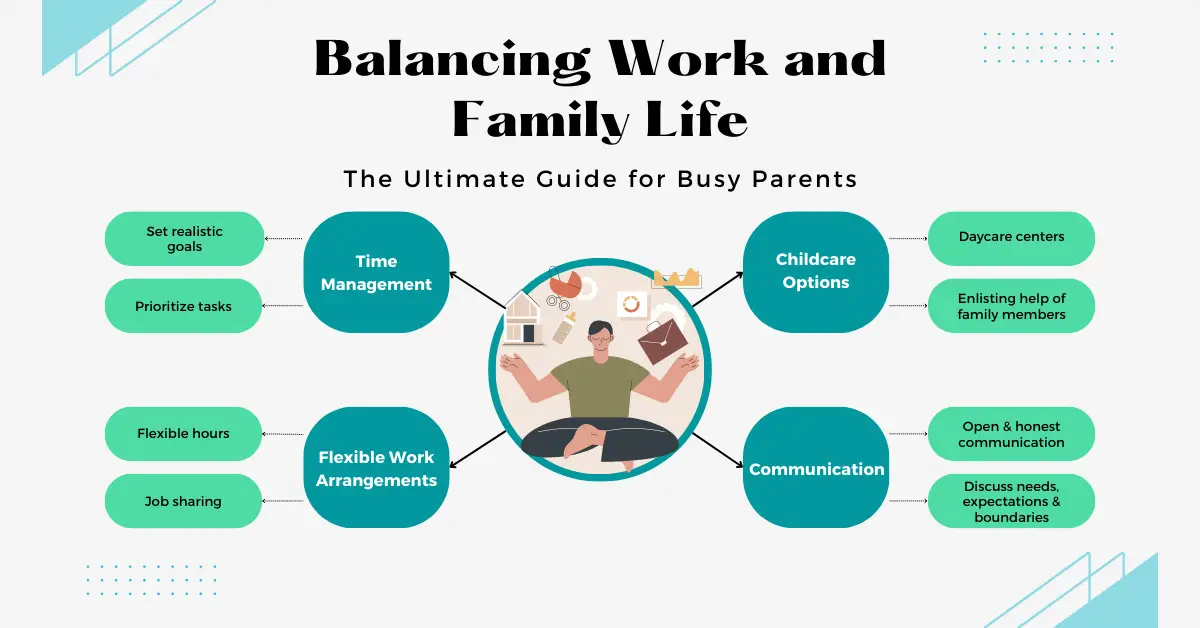Balancing Work And Family Life Is A Key Factor In Happiness
Today, we’re going to explore the wonderful world of achieving harmony between our professional and personal lives. We understand the challenges of juggling career, family, and personal well-being. Both Chad and I work full-time careers, run this blog, have 3 kids and work some time in for ourselves too.
But fear not! With the right tools and strategies, you can successfully navigate the tightrope of work-life balance. In this article, we’ll cover key aspects that will help you find equilibrium in your busy life. So, let’s dive in!
The Art of Time Management
Time management is the foundation of a balanced life. Start by setting realistic goals for yourself, both professionally and personally. Break these goals down into smaller, manageable tasks that can be accomplished daily or weekly. Prioritize these tasks based on their importance and deadlines.
Utilize tools like calendars, planners, and to-do lists to keep track of your responsibilities. Digital tools and apps, such as Google Calendar or Todoist, can help you stay organized and synchronized across all your devices. Time-blocking techniques, where you allocate specific blocks of time for different tasks, can help you stay focused and make the most of your day.
Remember to allocate time for work, family, and self-care, ensuring that you maintain a well-rounded lifestyle. Creating a daily or weekly routine can help you establish a predictable rhythm, making it easier to balance your various responsibilities.
Embracing Flexible Work Arrangements
Flexible work arrangements can significantly reduce stress and make balancing work and family life easier. Options such as telecommuting, flexible hours, and job sharing offer you the opportunity to tailor your work schedule around your family’s needs.
Speak with your employer about available options and how they can be implemented. If possible, propose a trial period to demonstrate the benefits and feasibility of these arrangements. Be prepared to negotiate and find a solution that benefits both you and your employer.
Consider the implications of each arrangement on your career growth, work relationships, and family life. For example, while telecommuting may offer more flexibility, it may also require additional effort to maintain strong professional connections and stay visible to your employer.
Exploring Childcare Options
Finding the right childcare solution is essential for maintaining a healthy work-life balance. Begin by assessing your family’s specific needs, such as your children’s ages, schedules, and any special requirements.
Consider options like daycare centres, which often provide structured environments and opportunities for socialization. When researching daycare centres, look for licensed facilities with qualified staff, appropriate child-to-staff ratios, and a strong emphasis on safety and cleanliness.
Alternatively, nannies and babysitters can provide more personalized care in the comfort of your own home. Interview potential candidates thoroughly and check references to ensure you find a trustworthy and experienced caregiver.
Enlisting the help of family members, such as grandparents, can also provide your children with a familiar and loving environment. Evaluate the pros and cons of each option to find the best fit for your family’s unique needs and preferences.
Communication
Open and honest communication is essential for achieving work-life balance. Make a conscious effort to engage in regular conversations with your partner, children, and colleagues. This helps you understand their perspectives, expectations, and concerns, ensuring that everyone is on the same page.
Establish a weekly family meeting to discuss upcoming events, address any issues, and set goals. Encourage each family member to share their thoughts and feelings, fostering a supportive and understanding environment.
At work, keep your colleagues and supervisors informed about your availability and any changes in your schedule due to family commitments. Be proactive in discussing your workload and seeking assistance when needed, demonstrating your commitment to your job while maintaining your work-life balance.
When conflicts arise, approach them with empathy and open-mindedness. Listen actively to others’ viewpoints and work together to find mutually agreeable solutions.
Prioritizing Self-Care
In the midst of juggling work and family, it’s crucial to remember the importance of self-care. Taking care of your physical and mental well-being ensures you have the energy and resilience to be fully present for your loved ones and career.
Set aside time for exercise, whether it’s a daily walk, a yoga class, or a weekly sports game. Physical activity not only improves your overall health but also helps reduce stress and boost your mood.
Incorporate relaxation techniques, such as meditation, deep breathing, or progressive muscle relaxation, into your daily routine. These practices can help you manage stress and maintain a sense of inner calm amidst the chaos of daily life.
Finally, make time for hobbies and activities that bring you joy and satisfaction. Engaging in these pursuits allows you to recharge and maintain a sense of identity outside of your roles as a parent and professional.

Sharing Household Chores
Sharing the responsibility of household chores prevents any one person from feeling overwhelmed and fosters a sense of teamwork within your family. Begin by identifying all the tasks that need to be completed, from cooking and cleaning to laundry and yard work.
Delegate chores based on each family member’s age, abilities, and preferences. Encourage children to participate in age-appropriate tasks, teaching them valuable life skills and fostering a sense of responsibility.
Create a chore chart or schedule to keep everyone accountable and ensure tasks are completed in a timely manner. Rotate chores periodically to prevent boredom and resentment.
Consider using technology to streamline household tasks, such as setting up automatic bill payments or utilizing grocery delivery services. These conveniences can save time and energy, allowing you to focus on more important aspects of work and family life.
Establishing Boundaries
Establishing clear boundaries between work and personal life is essential to prevent one from encroaching on the other. Define specific times and spaces dedicated to work and family, and communicate these boundaries to your loved ones and colleagues.
When working from home, designate a specific area as your workspace, and establish rules with your family regarding interruptions and noise levels. Turn off work-related notifications on your devices during family time, and avoid discussing work issues during meals or other family activities.
Likewise, resist the urge to bring personal concerns or distractions into your professional life. By maintaining these boundaries, you can remain fully present and focused in each aspect of your life.
Building a Support System
Cultivating a strong support system of friends, family, and fellow parents is invaluable when trying to achieve work-life balance. These individuals can provide advice, encouragement, and practical assistance during challenging times.
Join parenting groups or online forums where you can share your experiences and learn from others who face similar challenges. Participate in community events, playgroups, or workshops to expand your social network and form connections with like-minded parents.
When feeling overwhelmed or struggling to manage your various responsibilities, don’t hesitate to seek help from your support system. By leaning on one another, you can share the burden and foster a sense of community and understanding.
Planning Finances for Stability
Financial stability is a key component of work-life balance. Start by creating a detailed budget that outlines your income, expenses, and savings goals. This budget will serve as a roadmap for managing your finances and ensuring you live within your means.
Set up an emergency fund to cover unexpected expenses or income loss, providing a safety net for your family during difficult times. Additionally, plan for long-term financial goals, such as saving for your children’s education, retirement, or home ownership.
Regularly review and adjust your budget as needed, taking into account any changes in income or expenses. Utilize financial management tools and apps, such as Mint or YNAB, to track your spending and progress towards your financial goals.
Consider consulting with a financial planner or advisor to help you navigate more complex financial situations and develop a long-term strategy for financial stability.

Embracing Quality Family Time
Prioritizing quality family time is essential for building deep connections and fostering a sense of belonging among your loved ones. Plan regular activities, such as family game nights, movie nights, or outdoor adventures, to create lasting memories and strengthen your relationships.
Focus on being present and fully engaged during these moments. Put away your devices and make a conscious effort to listen and participate in conversations and activities. Encourage open communication and sharing of feelings, allowing each family member to feel heard and valued.
In addition to planned activities, seize spontaneous opportunities for connection, such as impromptu dance parties or heart-to-heart conversations. These moments, both big and small, contribute to a strong and loving family bond.
Conclusion
Achieving the perfect balance between work and family life may seem like an elusive goal, but with the right mindset, strategies, and dedication, it’s entirely possible. By implementing these tips and focusing on what truly matters, you’ll be well on your way to building a harmonious, fulfilling life for yourself and your family. So, go forth and find your balance, dear readers—you’ve got this!

